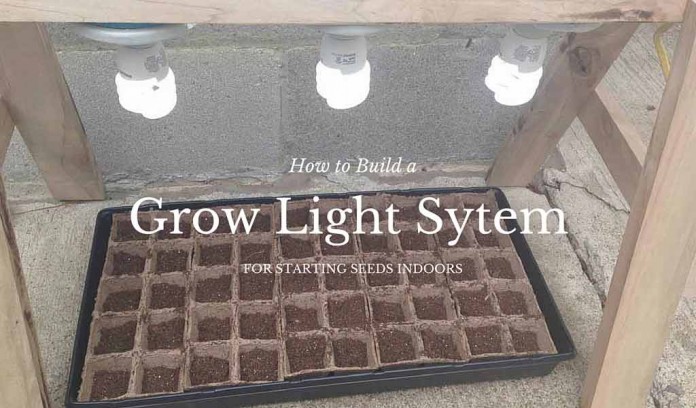Seeds need light and damp, warm soil to grow indoors. If you want to start seeds indoors this spring, you’ll need an environment that provides 14-18 hours of light each day. Placing your seeds and seedlings near a south-facing window will give light throughout the daytime hours, but you’ll want to give your seeds a little extra light once the sun goes down.
To make sure your seedlings get enough light, build a light system for about $50 to keep your seedlings growing and healthy before transplanting outdoors later this spring. It takes a trip to your local home improvement store a few hours time.
There is more than one way to construct a grow light system. You can use individual light bulbs or fluorescent tube lighting. Directions for both plans are below. All photos show the individual light bulb version, but the frame is the same for the fluorescent tube lighting system.
Note: Wear safety glasses while constructing your grow light system.
How to build an A-frame grow light system with light bulbs
More about starting seeds indoors:
Starting seeds indoors: What you need to know
This option is ideal if you would like to save a little money on supplies. However, you will have to wire the lights, so if you do not have electrical wiring experience, you must consult a professional.
The plans for this grow light system are for a 28” x 16” x 16” lighting system. You will be able to fit a 50-cell planting tray under the lights of this system, with a few inches of extra space on each side.
What you’ll need
Parts
- 3 60W Equivalent Daylight spiral CFL light bulbs (base must fit standard socket)
- 3 round hard-shell ceiling boxes (electrical boxes) (25 cubic inches)
- 3 porcelain keyless lamp holders (to fit 3 ¼” or 4” box)
- 1 15-amp 125-volt 3-way straight blade grounding plug
- 12-2 electrical wire (purchase 15 feet to ensure you have enough to connect light system to outlet or power strip)
- 16 1-¼” Wood Screws
- 1 common board (1”x6”x8’)
Tools
- Power drill
- Chisel (if electrical boxes have flanges that need to be removed)
- Rubber mallet (if electrical boxes have flanges that need to be removed)
- Miter saw
- Table saw
- Router (optional)
- 1/16” drill bit (optional)
- Silicon caulk (optional)
- Wood glue (optional)
- Wire cutters
- Wire strippers
- Phillips head screwdriver
Directions
-

(Katie Woods photo) Begin by cutting your board into the pieces needed: the A-frame legs, braces and top board, which is where the lights will be attached.
- A-frame legs:
- Dimensions: ¾” x 2 ½” x 17 ¾”
- Cut a 17-degree miter on either end (these cuts must be parallel to one another).
- Cut to length with miter saw.
- Cut to width with table saw.
- Top board:
- Dimensions: ¾” x 4 ⅝” x 26 ½”
- Both long sides should have a 17-degree bevel. These should not be parallel.
- Cut to length with miter saw.
- Bevel and cut to width with table saw.
- Both long sides should have a 17-degree bevel. These should not be parallel.
- Dimensions: ¾” x 4 ⅝” x 26 ½”
- Side braces
- ¾” x 2” x 12”
- Both sides should have non-parallel 17-degree miters.
- Cut to length with miter saw.
- Bevel and cut to width with table saw.
- Both sides should have non-parallel 17-degree miters.
- ¾” x 2” x 12”
- A-frame legs:
- Attach electrical boxes directly to bottom of top board. This will lower bulbs approximately 4 inches, depending on the type of electrical boxes you purchased. If you want more space between lights and plants, you will have to cut holes in the top to mount the electrical boxes. To do so, complete the following steps:
- Lay out 3 equally-spaced holes on top of board.
-

Drilling a pilot hole for the electric boxes (Katie Woods photo) The holes should be big enough to snugly fit the round electrical boxes. They should not be so large that the boxes will fall out.
- Depending on what type of electrical box you purchased, you may need to remove the nailing flanges with a chisel and rubber mallet.
- Drill a pilot hole. Remove the rest of the stock with router or jigsaw.
- If you have a hole saw of the appropriate size, it can be used and will make this process easier.PROS: Aesthetics; gives extra height between bulbs and plants.
CONS: Requires use of a hole saw, router or jigsaw. Adds difficulty to the project.
- If you have a hole saw of the appropriate size, it can be used and will make this process easier.PROS: Aesthetics; gives extra height between bulbs and plants.
-

Assembled grow light system before wiring (Katie Woods photo) Assemble Parts
- Optional: Pre-drill the screw holes with the 1/16” drill bit to ensure the wood doesn’t split when you put the screws in. If you don’t pre-drill, the ends of the wood may split.
- Optional: Apply wood glue to all joints to strengthen overall structure.
- Attach the legs to the beveled edge of the top with 2 screws in each.
- Place side braces so they are flush with the outside of leg and attach.
- Put electrical boxes in holes. Carefully tap in with mallet if necessary.
- Optional: Caulk around boxes to hide any cracks.
- Wire in lights.
- Run the wire into the first box and connect the white wire to the silver screw, the black wire to the gold screw and the base wire to the green screw.
-

(Katie Woods photo) Attach fixture to box with screw.
- Run the wire into the next box in line. Leave about 6 inches and cut the wire and strip the coating. Run another length of wire in from the other side of the box, then connect both white wires to the silver screw and both black wires to the gold screw. Twist both copper wires together or attach both to the green screw.
- Attach fixture to box with screw.
- Repeat that process for the next light.
- Run as much wire as you want for a cord and cut and strip the wire. To attach plug, loosen the screws and remove the face of the plug. Slide plug casing onto the cord. Now attach the white wire to the silver screw, the black wire to the gold screw and the copper wire to the green screw. Slide the casing up and reattach the plug face.
- Screw in light bulbs

How to build an A-frame grow light system with fluorescent tube lighting
This option may cost a little more because of the tube lights and fixture, but you don’t have to wire the lights.
The plans for this grow light system are also for a 28” x 16” x 16” lighting system, so you can still fit a 50-cell planting tray under the lights.
What you’ll need
Parts
- 2 23” fluorescent bulb light fixtures (about $20 each; each will include a 13 watt bulb)
- 16 1-¼” Wood Screws
- 1 common board 1”x6”x8’ (these boards are usually ¾” in height, which is why the following directions give ¾” for dimensions)
Tools
- Power drill
- Miter saw
- Table saw
- Wood glue (optional)
Directions
- Begin by cutting your board into the pieces needed: the A-frame legs, braces and top board, which is where the lights will be attached.
- A-frame legs:
- Dimensions: ¾” x 2 ½” x 17 ¾”
- Cut a 17-degree miter on either end (these cuts must be parallel to one another).
- Cut to length with miter saw.
- Cut to width with table saw.
- Top board:
- Dimensions: ¾” x 4 ⅝” x 26 ½”
- Both long sides should have a 17 degree bevel. These should not be parallel.
- Cut to length with miter saw.
- Bevel and cut to width with table saw.
- Both long sides should have a 17 degree bevel. These should not be parallel.
- Dimensions: ¾” x 4 ⅝” x 26 ½”
- Side braces
- ¾” x 2” x 12”
- Both sides should have non-parallel 17 degree miters.
- Cut to length with miter saw.
- Bevel and cut to width with table saw.
- Both sides should have non-parallel 17 degree miters.
- ¾” x 2” x 12”
- Assemble parts
- Optional: Pre-drill the screw holes with the 1/16” drill bit to ensure the wood doesn’t split when you put the screws in. If you don’t pre-drill, the ends of the wood may split.
- Optional: Apply wood glue to all joints to strengthen overall structure.
- Attach the legs to the beveled edge of the top with 2 screws in each
- Place side braces so they are flush with the outside of leg and attach.
- Place structure on the top board, so the legs are sticking up. Attach fluorescent bulb light fixtures.














Great and very helpful post! I’m almost done with my seed starters, but my sister will be very glad to have your tips and advice. It’s her first year of gardening and although she’s buying most of her transplants, she’ll surely try to start some seeds by herself. So your post is exactly what she needs. Thank you for sharing. Happy gardening!
Hi Maxine,
I’m glad to help! Thanks for reading!
Katie